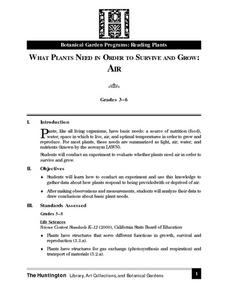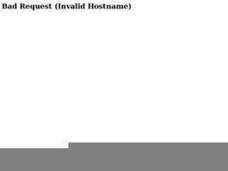Curated OER
Three Healthful Meals: A Practical Food-Guide-Pyramid Activity
Students activate their knowledge of the food guide pyramid and the basic food groups in order to plan nutritious meals. They collect a handful of food images from magazines and glue them to the appropriate plates.
Curated OER
Soil Nutrients - Phosphorus Lab Lesson Plan
Students list sources of phosphorus in soil. They explain how phosphorus is removed from the soil and used by plants. Students list the symptoms of insufficient or excess phosphorus. Students perform experiments to examine the effect of...
Curated OER
Hunger and Malnutrition
Sixth graders use a variety of resources to determine the importance of getting the proper nutrients. In this nutrition lesson, student complete an activity in which they examine the world issue of hunger and malnutrition. They locate...
Curated OER
PICTURE PERFECT PYRAMID
Learners create a model of the USDA's Food Pyramid Guide, using shoe boxes. They bring an assortment of shoe boxes from home. Students are given a copy of the "Food Guide Pyramid." They wrap boxes for the bread group in white, the...
Curated OER
Non-Nutrients: Fiber and Water
Students discuss how much fiber and water a person needs each day. They use beans soaked in water to show the benefits of water to the human body. They also learn the health benefits to eating healthy.
Curated OER
Food Chains, Food Webs, Biomass Pyramids and Cycle
In this food chain instructional activity, students review terms associated with food chains and food webs. Students also recall the water cycle.
Curated OER
A Healthy Diet is a Balancing Act
It's important to teach kids how to have a balanced diet. They are provided with six different meals, they fill in the blanks to complete each one to make it balanced. The answers could be anything and the meals offered don't seem very...
Curated OER
The Chemistry of Fertilizers
Young scholars use a series of hands-on labs and activities, practice problems, discussions and writing assignments, students investigate about fertilizer chemistry as they break compounds into ions, make a fertilizer and test various...
Curated OER
Let's Make a Compost Cake
Students create a compost cake. For this gardening and decomposition science lesson, students review and describe the "nutrient cycle." Students create a compost pile, measure and record the dimensions and temperature of the pile, and...
Curated OER
What Plants Need in Order to Survive and Grow: Air
Students conduct an experiment to determine whether plants need air in order to survive and grow. They discuss natural resources, analyze slides, and observe and record data from the experiment.
Curated OER
Ocean World
In this components of the ocean worksheet, students answer 20 questions about various species in the ocean such as plankton, different types of whales, sharks, and herring. Students also answer questions about the volume of water in the...
Curated OER
Forest Food Webs
Students consider the interdependency of life in a temperate forest by studying selected organisms from an Asian temperate forest and creating a food web.
Curated OER
Steps to a Healthier You
Students explore the food pyramid. In this dietary health instructional activity, students examine the food pyramid on the MyPyramid.gov website and discuss healthy eating strategies. There are various links to websites in this...
Curated OER
Behavior Assessment & Nutrient Needs
Students identify the factors that influence eating behaviors. They discover the nutrients that are needed in a teenager's body. They also identify the major food groups and examine the food pyramid.
Curated OER
Where Do I Fit In The Food Pyramid?
Students discuss how their daily diets fit into the dietary guidelines set out by the food pyramid. They write a paragraph describing good health habits and identify areas where their personal diet can be improved.
Curated OER
Food: Habits and Holidays
In this foods of the world instructional activity, students answer true and false questions about their own eating habits, than complete a matching activity where they match foods with countries of the world.
Curated OER
Explore the Food Web
Students identify plants and animals in the journals of Lewis and Clark's expedition. They describe the various animal habits. Students interpret the behaviors of the animals discovered on the expedition. They design a food web using...
Curated OER
Life In Extreme Environments
Pupils work together to design and participate in experiments to determine the rate rotifers eat. After completing their experiments, they record and analyze their data and identify any challenges faced during the procedure. They...
National Park Service
The Secret of Life
Dead trees provide nutrients for the soil, food for animals, protection and a home for organisms, a seed-bed for new trees, and a place for nitrogen-fixing bacteria to live. In the activity, pupils collect decaying logs, expose them to a...
United Nations
Compost Monitor Training
What should go in the trash, and what can be composted? Guide your young conservationists through the process of composing their trash with a instructional activity about the different ways we can dispose of garbage. Using a trash bag...
Curated OER
Label Language
Students practice reading food labels. In this nutrition lesson, students bring in examples of food labels and practice identifying the nutrients in each of the foods. Students determine what changes should be done to the food label to...
Curated OER
Label It Nutrition
Pupils rank foods for particular nutrients, and check to see if they are correct using the Nutrition Label.
Curated OER
Nutrition
Students design a meal plan with healthy foods based on the food guide pyramid. In this nutrition lesson plan, students identify healthy and unhealthy choices, watch a PowerPoint, and complete a group activity based on the food pyramid.
Curated OER
Carbohydrates
In this carbohydrates activity, students review the six groups of nutrients needed for the human body. Students focus on sugars and carbohydrates, the sources of these nutrients and how the body uses these nutrients. This activity has 4...























